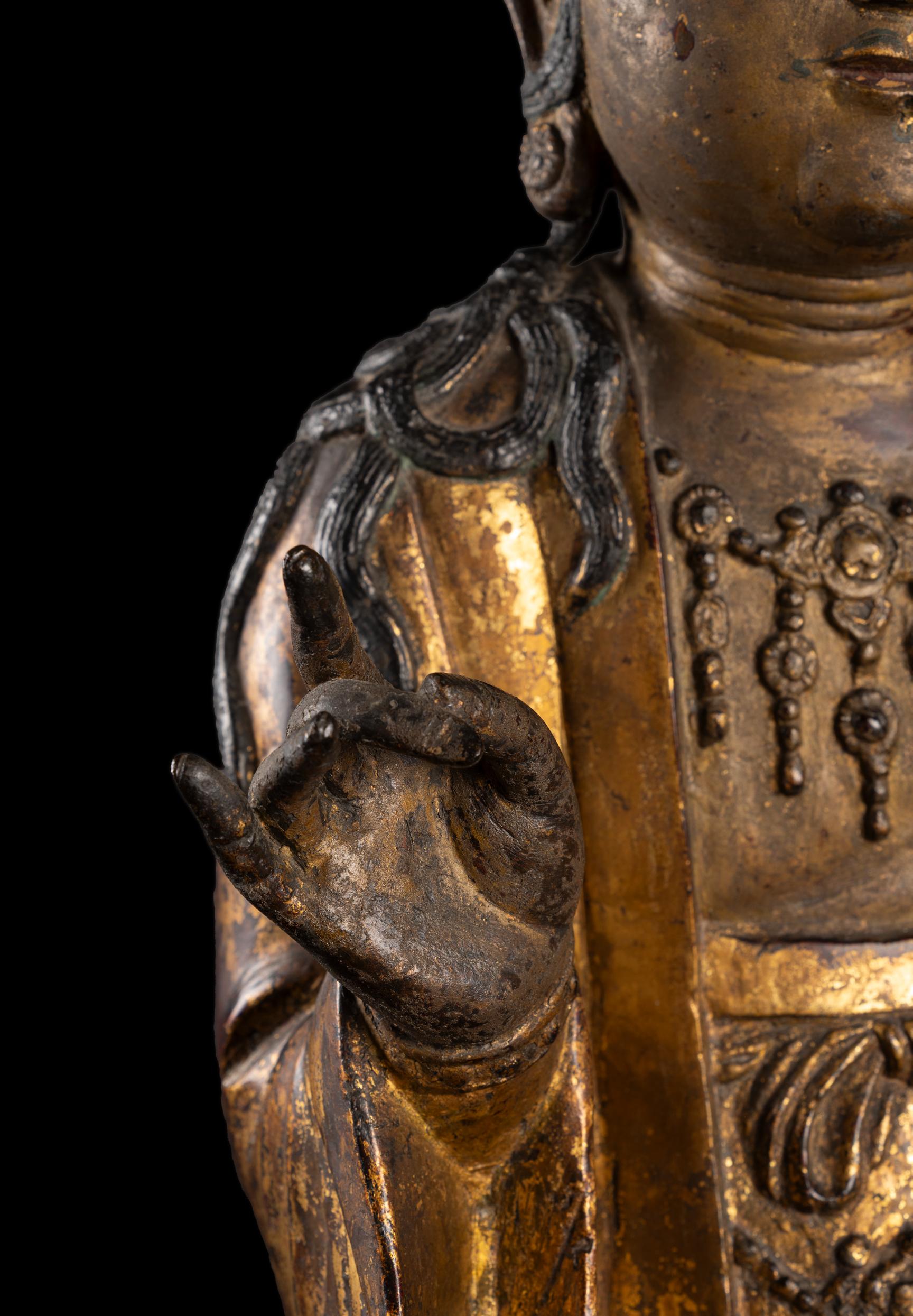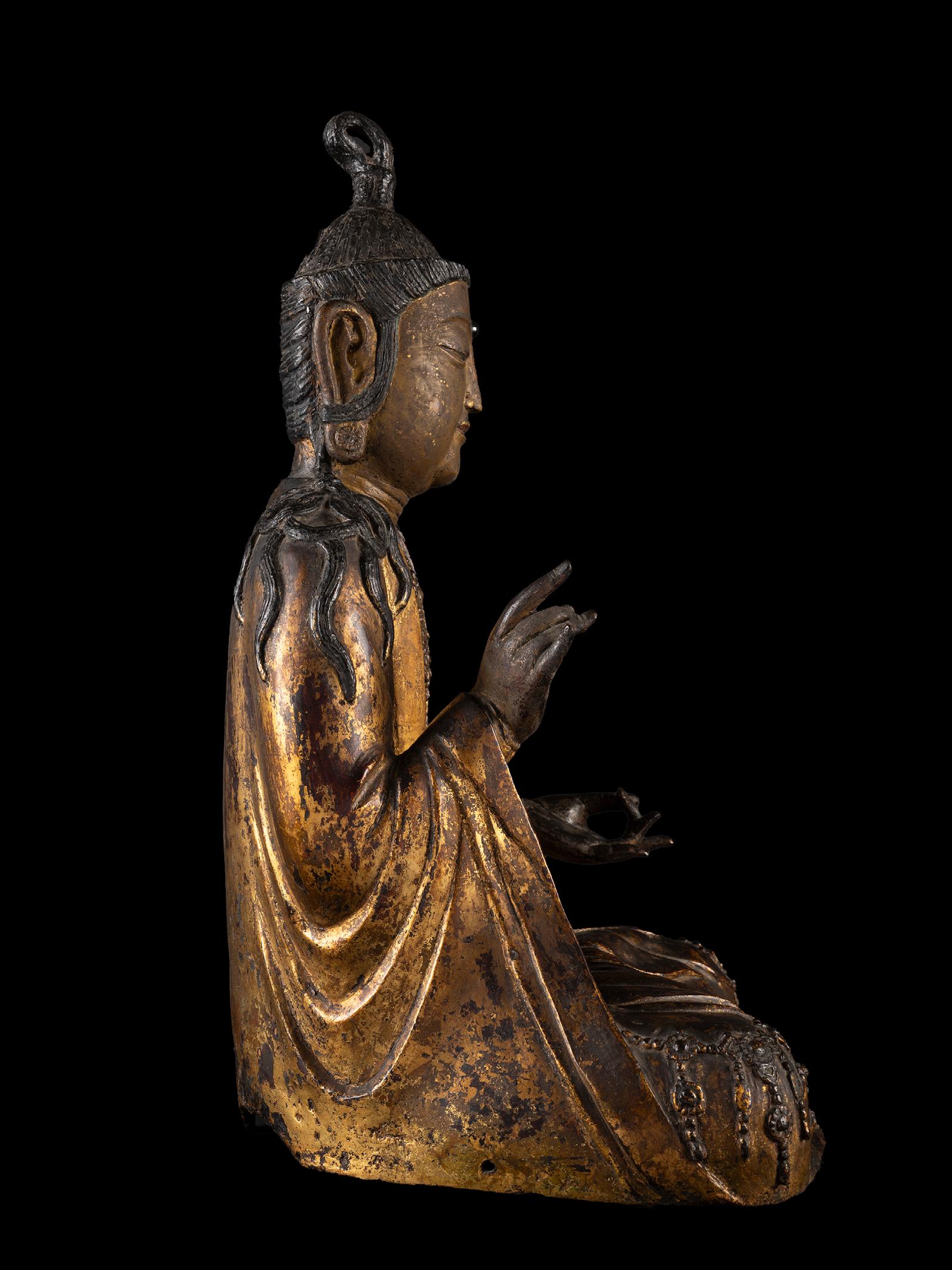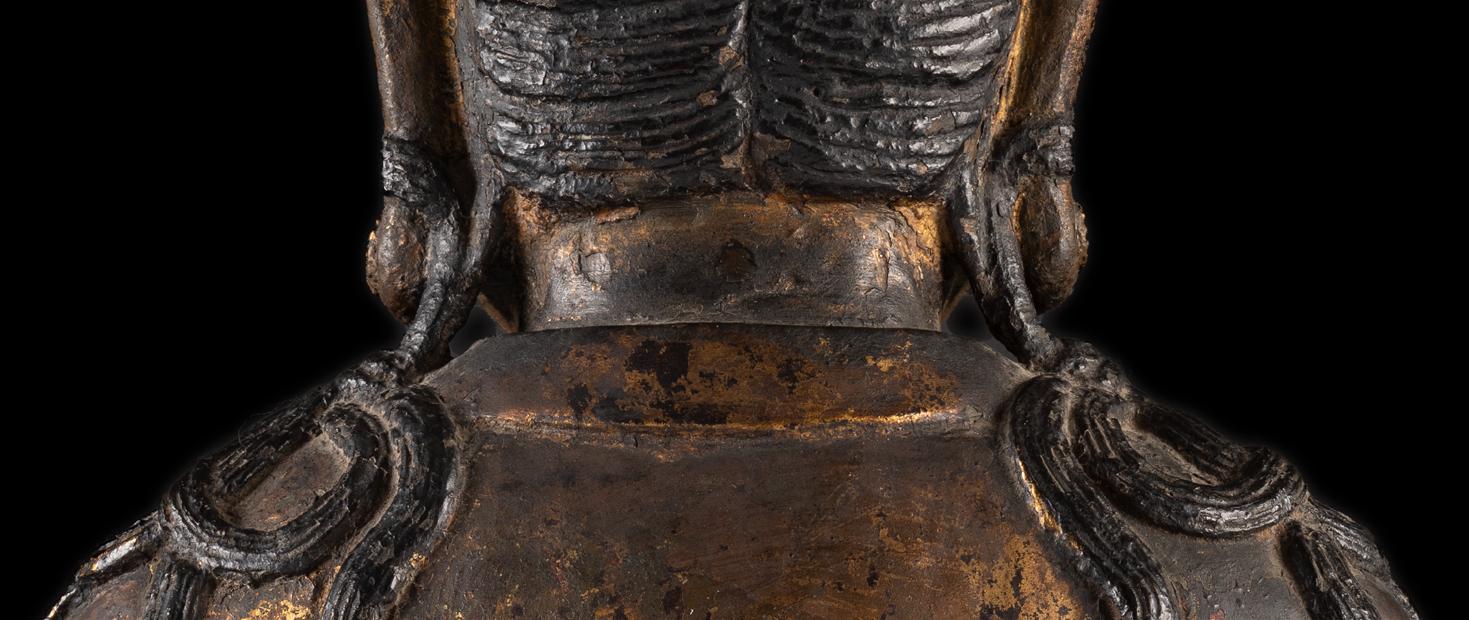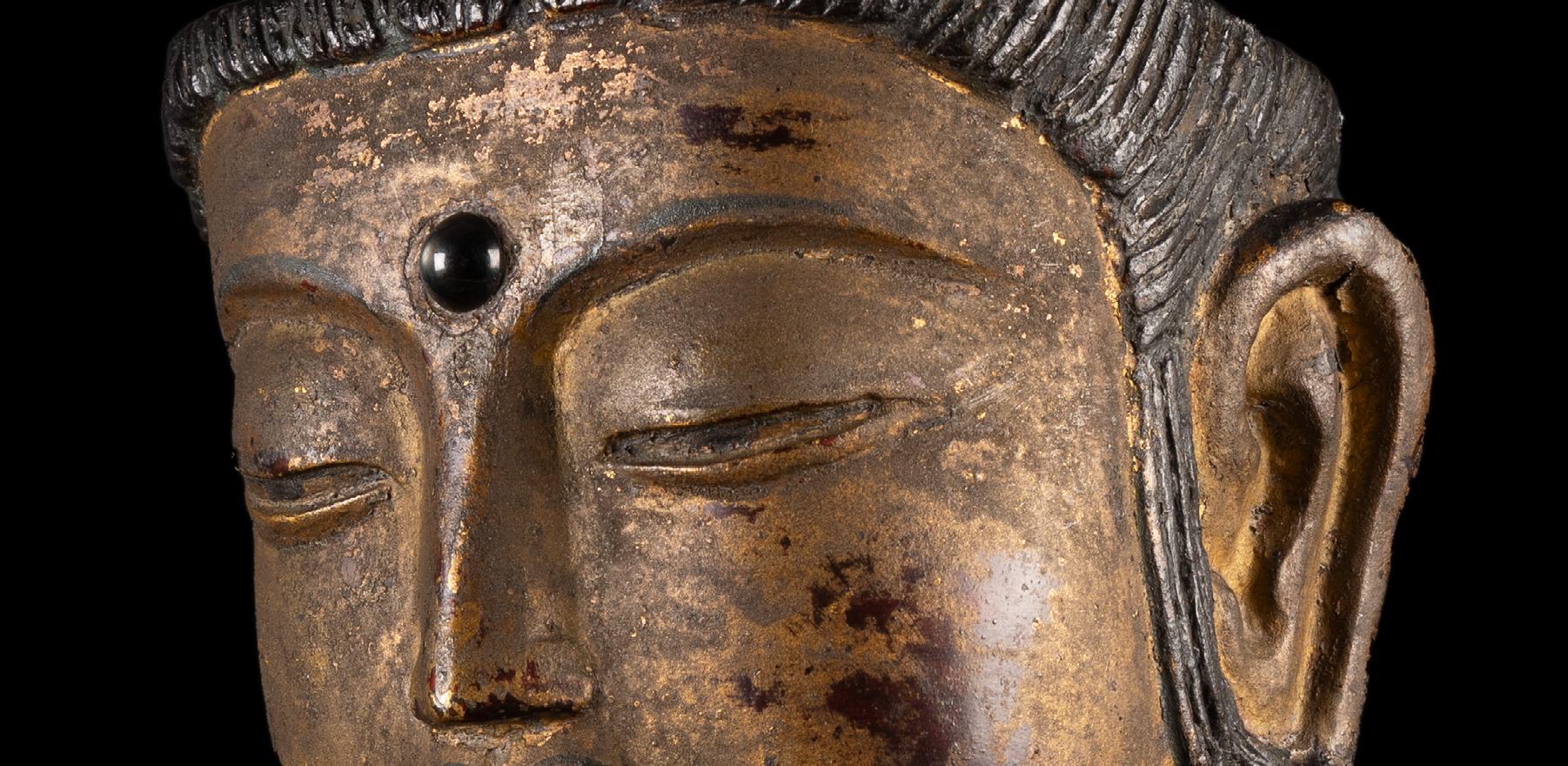
AN EXTREMELY RARE AND IMPORTANT LARGE GILT-BRONZE FIGURE OF GWANSE-EUM BOSAL
FROM A PRIVATE ITALIAN COLLECTION
AN EXCEPTIONALLY RARE AND IMPORTANT LARGE GILT-BRONZE FIGURE OF GWANSE-EUM BOSAL,
Korea, Goryeo period (918-1392), 12th/13th century h cm 52
Seated in dhyānāsana, he holds his hands in shuni mudrā. He wears a broad draped robe that falls over a tied dhotī, covering both feet. Lavish rosette-shaped jewels descend from the neck to ornament the chest, recur across the garment and punctuate the earlobes.
Long lacquered-black locks fall in waves over the shoulders and are gathered into a chignon at the crown. The serene face is distinguished by a painted moustache and beard and by half-closed eyes with visible pupils. An ūrṇā inlaid with rock crystal is set at the centre of the forehead.
Provenance: From a private collection, Milan.


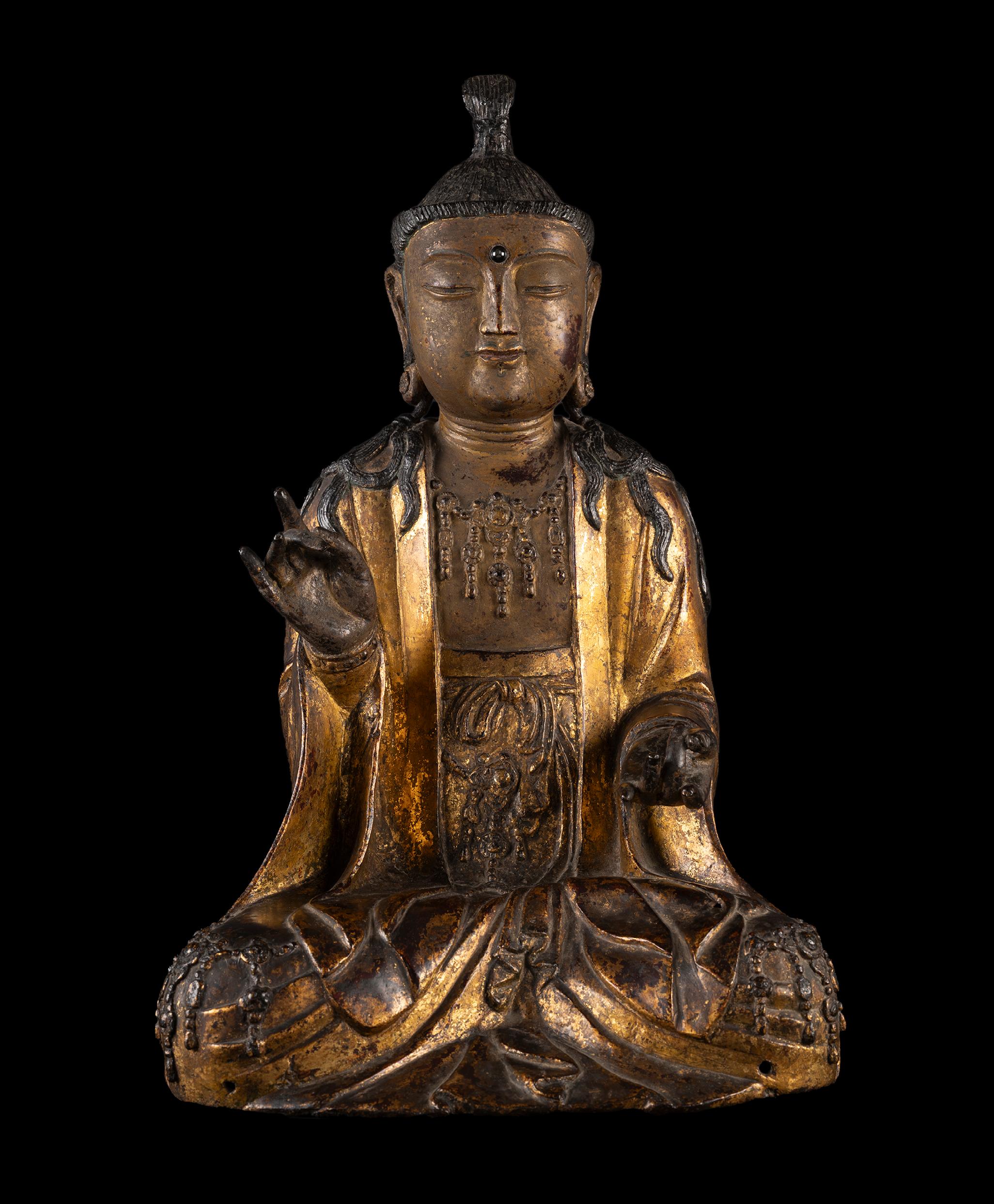
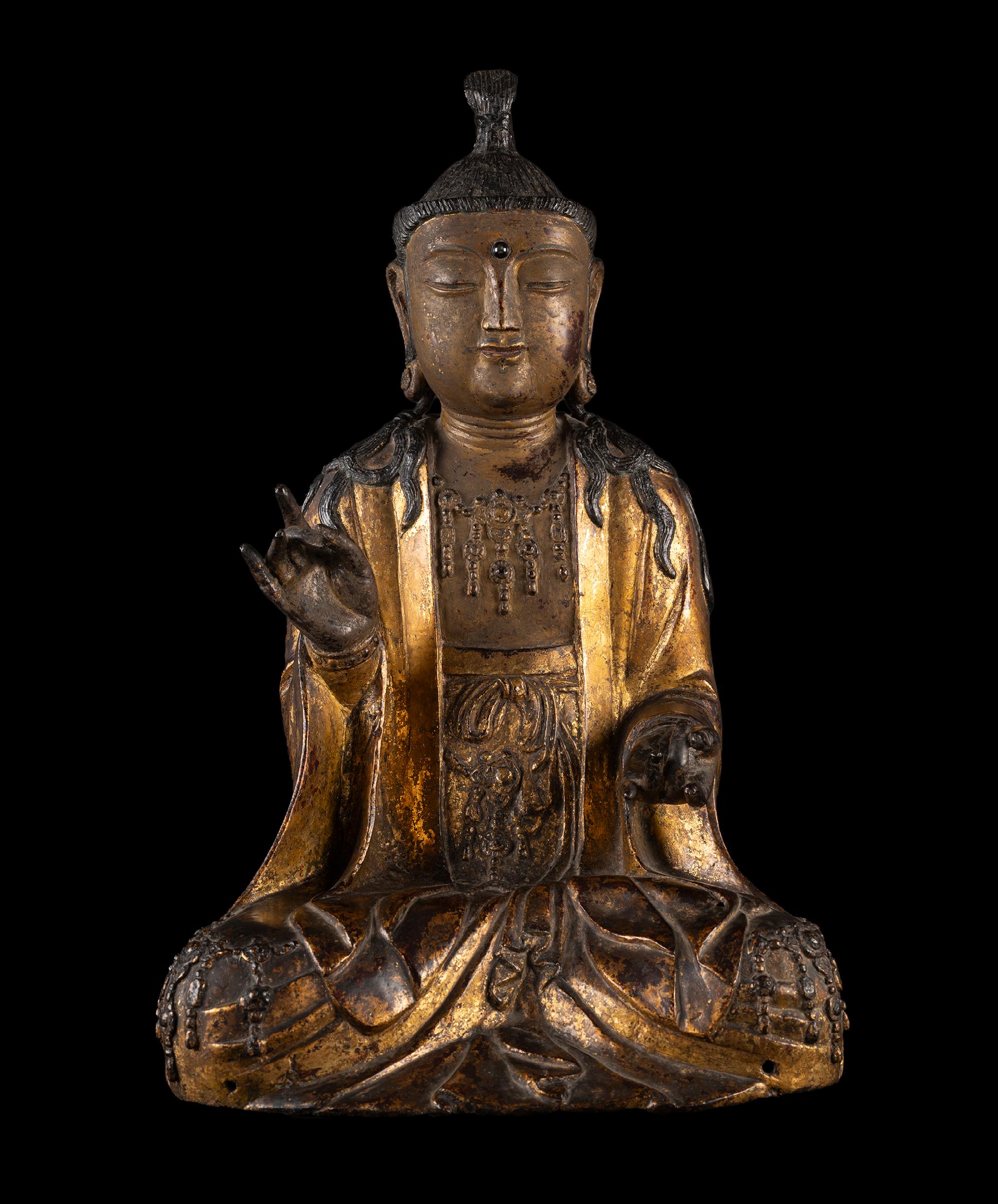
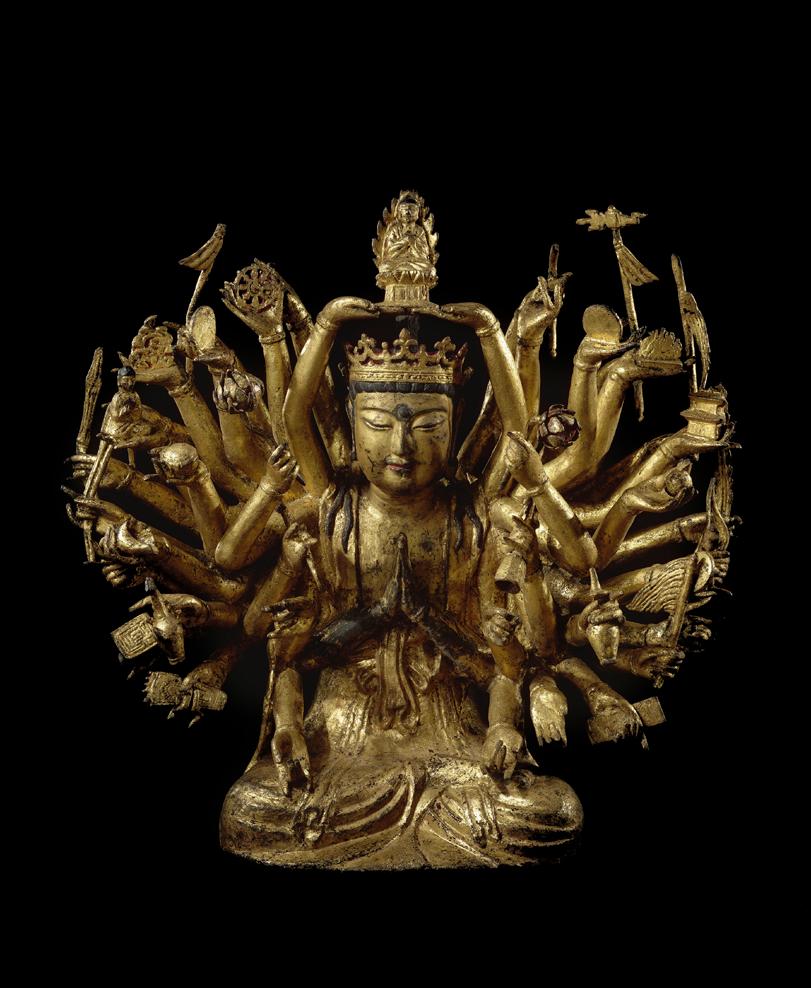
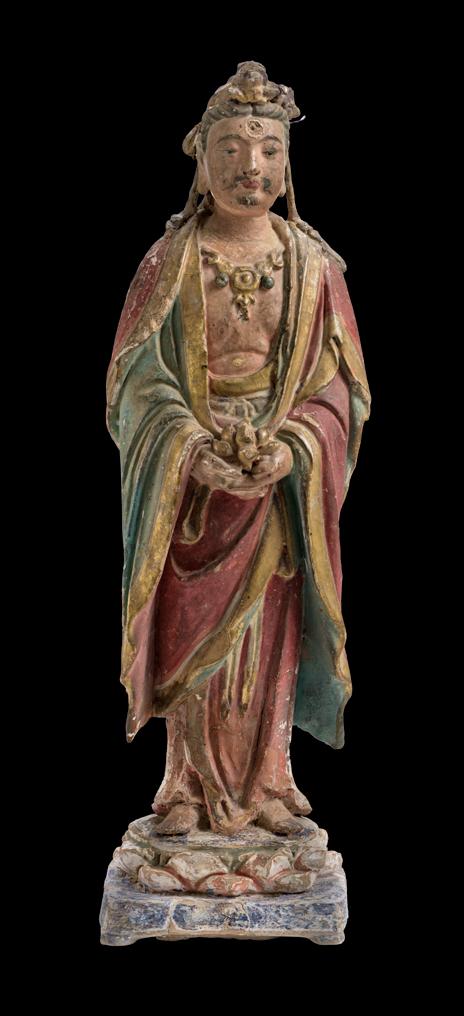
Notes
Large-scale gilt-bronze images of Avalokitesvara became characteristic of the Goryeo period1, reflecting the widespread diffusion of Buddhism at that time2. Production of bronzes of this type intensified from the mid-Goryeo period (c. 12th–13th centuries), when bronze largely supplanted iron as the preferred medium for monumental statuary previously common in the early Goryeo phase (c. 10th–12th centuries)3 .
The present sculpture, example of technical mastery attributable to the mid-Goryeo period, yet it retains features typical of the early Goryeo phase, notably an idealized face with markedly elongated eyes4. Indeed, the same facial traits – including the painted moustache and beard – and comparable expression appear in the large gilded iron statue of Cheonsu Gwanseum Bosal in the Musée Guimet5, Paris (fig.1), dated to the 10th–11th centuries. Other relevant parallels concern the treatment of the hair and the drapery — particularly the triangular hem that falls over both knees and the pointed tie that secures the inner garment.
The clear Chinese features visible in the present bronze — especially in the facial modelling — are characteristic of the midGoryeo period6. In particular, the sinuous locks falling over the shoulders are a distinctive sign of Song (960–1279) influence upon mid-Goryeo sculpture7. This influence is readily appreciated in comparison with a Chinese wooden sculpture of the Southern Song dynasty (1126–1279) representing Avalokiteśvara, now preserved at Sennyūji temple8, Japan. The subject, pose and facial expression — half-closed eyes, hair laid over the shoulders, moustache and beard painted and a conspicuous necklace on the chest — correspond closely. These parallels, together with the documented maritime transmission of iconographic types, indicate that Goryeo ateliers reworked Song prototypes into sculpted and cast forms suited to regional circulation, particularly in the case of images of Avalokiteśvara9 .
See also the Northern Song (960–1127) ceramic Avalokiteśvara in the collection of the Los Angeles County Museum of Art10 (fig. 2): the facial rendering, with moustache and beard painted beneath the nose and on the chin, is strikingly analogous to that of the present bronze statue, as is the necklace.
A comparable gilt-bronze figure of a bodhisattva of the mid-Goryeo period, dated to the 12th–13th centuries, is conserved in a Japanese collection11 and it displays all the typical period traits: both works wear a heavy outer robe12 that falls along the arm with broad sleeves and long undulating hair that descends over the shoulders; the upper garments fall like a sleeve and form a triangular hem over both legs13 and in both examples the pointed termination of the innergarment fastening is visible. One notable difference in the present piece is the profusion of jewellery. Junghee Lee identifies such ostentatious ornamentation as more typical of the late Goryeo period (13th–14th centuries)14 plausibly deriving from Liao (907–1125), Jin (1115–1234) and Yuan (1271–1368) Chinese influences15; however, as noted above, Song images were already depicted with conspicuous jewellery16.
Mid-Goryeo examples bearing ornamentation are attested17, notably the gilded wooden Gwaneum Bosal at Bongjeongsa18, Andong (c. 1199). This work shares Southern Song–derived formal traits19 with the present bronze — a bold, dignified facial expression; locks of hair falling over the shoulders; an outer robe that covers the shoulders; billowing sleeves terminating in triangular hems that drape across the knees. Together with the jewellery adorning the ears, chest and drapery at thigh level, further correspondences can be observed in the pose, the painted moustache and beard, and the long, slightly inclined eyes. Another important comparison is a gilded wooden Gwaneum Bosal in lalitāsana (royal-ease pose) in the collection of the National Museum of Korea20, Seoul, dated to the 13th century and exhibited at the Arthur M. Sackler Gallery, Washington, D.C., in "Sacred Dedication: A Korean Buddhist Masterpiece" (21 September 2019–31 May 2020) (fig. 3). The facial expression — with slightly slanting and elongated eyes and painted moustache and beard — the locks of hair falling over the shoulders, and the chest and garments ornamented with jewellery correspond closely to the bronze example. These transitional stylistic elements from mid-to late-Goryeo are also apparent in a gilt-bronze figure of bodhisattva Mahasthamaprapta dated to the 13th–14th centuries, preserved at Fumyo-ji temple in Japan and shown in the exhibition "Goryeo Dynasty: Korea’s Age of Enlightenment", 918–1392 at the Asian Art Museum, San Francisco (Chong-Moon Lee Center for Asian Art and Culture, 18 October 2003–11 January 2004)21; Junghee Lee describes, in this group, the introduction of ornament that traverses the torso with a large central rosette as a stylistic innovation22.
The late Goryeo period, as Junghee Lee has observed, is defined by recurrent canons in bodhisattva imagery23: a large head, compact proportions, short legs, a ribbon-decorated buckle, an imposing necklace, sumptuous rosette jewellery, heavy drapery, V-shaped sleeve openings and a triangular upper-robe hem resting on the thigh. Some of these are also visible on the present statue24.
Comparable iconographic types that differ stylistically are found in the late Goryeo corpus; foremost among these is the 14th century sculpture of Gwaneum Bosal in the collection of the Jeonju National Museum25 (fig. 4). There the coiffure and hand position (with long, tapering fingers) are very similar; the gilding is comparable in technique and surface effect — widespread and uniform on the robe, and surviving only in small traces on face, chest and hands — and the lavish jewellery belongs to the same typology. Differences in facial expression, the absence of the triangular hem on the right thigh and the lack of the pointed fastening ribbon for the inner robe, together with the more slender proportions of the sculpture, suggest a possibly earlier date for the present example.

Fig. 3. Mokjo Gwan-eum Bosal Jwasang (목조관음보살좌상; Acc. no. 덕수953) This work uses ‘Mokjo Gwan-eum Bosal Jwasang (목조관음보살좌상; Acc. no. 덕수953)’, created in n.d. (no date provided) by the National Museum of Korea (국립중앙박물관) and released under Korea’s Public-use license, KOGL Type 1 (공공누리 제1유형 — Attribution required). The original may be downloaded free of charge from the National Museum of Korea website (museum.go.kr). (https://www.kogl.or.kr/info/licenseType1.do).
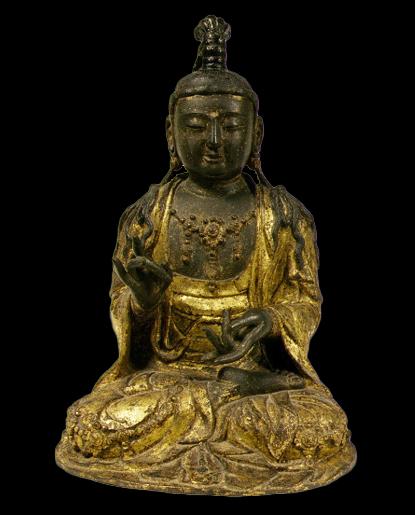
Fig. 4. Dongje Gwanse-eum Bosal Jwasang (동제관세음보살좌상; Acc. no. 덕수4238). This work uses ‘Dongje Gwanse-eum Bosal Jwasang (동제관세음보살좌상; Acc. no. 덕수4238)’, an object housed at Jeonju National Museum (국립전주박물관), created in n.d. (no date provided) and made available by the National Museum of Korea (국립중앙박물관) under Korea’s Public-use license, KOGL Type 1 (공공누리 제1유형 — Attribution required). The original may be downloaded free of charge from the National Museum of Korea website (museum.go.kr). (https://www.kogl.or.kr/info/licenseType1.do).

Fig. 5. Geumdong Bosal Jwasang (금동보살좌상; Acc. no. 구6241)
This work uses ‘Geumdong Bosal Jwasang (금동보살좌상; Acc. no. 구 6241)’, created in n.d. (no date provided) by the National Museum of Korea (국립중앙박물관) and released under Korea’s Public-use license, KOGL Type 1 (공공누리 제1유형 — Attribution required). The original may be downloaded free of charge from the National Museum of Korea website (museum.go.kr). (https://www.kogl.or.kr/info/licenseType1.do).
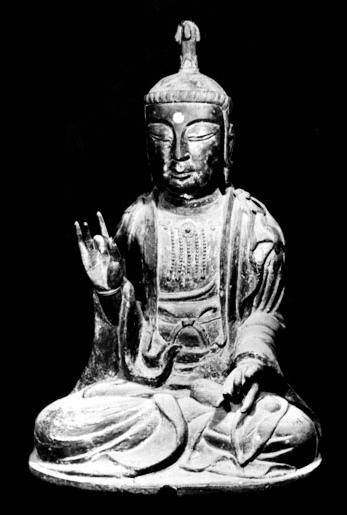
Fig. 6. Geumdong Bosal Jwasang (금동보살좌상; Acc. no. 덕수75)
This work uses ‘Geumdong Bosal Jwasang (금동보살좌상; Acc. no. 덕수75)’, created in n.d. (no date provided) by the National Museum of Korea (국립중앙박물관) and released under Korea’s Public-use license, KOGL Type 1 (공공누리 제1유형 — Attribution required). The original may be downloaded free of charge from the National Museum of Korea website (museum.go.kr). (https://www.kogl.or.kr/info/licenseType1.do).
To trace the development of the style and distinctions within the late period, consult also the 14th century Gwaneum Bosal originally gilded and preserved at Kannon-ji Temple26, Tsushima and two 14th century figures held by the National Museum of Korea27, Seoul (fig. 5, fig. 6).
Finally, from an iconographic perspective, depictions of Avalokiteśvara became especially popular during the Goryeo dynasty, particularly in the Water-and-Moon Avalokiteśvara type28, as widely seen in 14th-century paintings, including those in the Metropolitan Museum of Art29, New York (fig. 7), and the Smithsonian’s National Museum of Asian Art, Washington, D.C.30. As Junghee Lee observes: “these depictions were not popular during the Liao and Yuan periods, but they were in the Song and Jin periods in China, as well as in late Goryeo, indicating that Song iconography remained relevant. Although the opulent style of the images is of Yuan date, the iconography remained traditional”31.
Together with the gilt-wooden statue of Water-and-Moon Avalokitesvara in the National Museum of Korea, the gilded iron example at the Guimet and the wooden figure at Bongjeongsa, the present work attests to the depiction of this bodhisattva already before the late Goryeo period, mitigating the perceived scarcity of such images and highlighting how the forms that became widespread in the late period gradually evolved from earlier prototypes.
This large gilt-bronze functions as a crucial intermediary example within the Goryeo corpus, bridging mid-and late-Goryeo idioms. Its combination of a compact, orthogonal body, painted moustache and beard, long locks gathered into a chignon, and extensive rosette jewellery aligns it closely with the Sennyūji wooden example and the gilded wooden Gwaneum Bosal at Bongjeongsa. Rather than representing a mere adoption of Song prototypes, this bronze demonstrates how Goryeo sculptors synthesized Chinese formal elements (notably Song hair and facial modelling) with local conventions (heavy drapery, triangular hems, and specific ornament typologies), producing a distinct regional variant that was evidently mobile across East Asian networks: Goryeo played a significant role in shaping Avalokiteśvara32, and the present bronze stands as a clear witness to this development.
In conclusion, the coexistence of Song-derived elements and all the distinctive characteristics of the mid-Goryeo phase that place this sculpture in that point — combined with the incipient iconographic and stylistic innovations of the late dynasty — make this object a singular and precise marker of stylistic development within the Goryeo period. Above all, given that the Bongjeongsa statue is probably the product of local aristocratic patronage in Goryeo33, the close resemblance of the present bronze suggests that it may represent another significant instance of such patronage.
1. Pak and Whitfield 2002, pag. 366.
2. Pak and Whitfield 2002, pag. 366; K. P. Kim, Choi, Ide, J. Y. Kim, Lee, Pak and Shulz 2003, pag. 140.
3. K. P. Kim, Choi, Ide, J. Y. Kim, Lee, Pak and Shulz 2003, pag. 141.
4. C. Kim and W. Kim 1966, pag. 169.
5. Cat. MG 15369, https://www.guimet.fr/fr/nos-collections/coree/avalokiteshvara-mille-bras.
6. K. P. Kim, Choi, Ide, J. Y. Kim, Lee, Pak and Shulz 2003, pag. 14.
7. K. P. Kim, Choi, Ide, J. Y. Kim, Lee, Pak and Shulz 2003, pag. 142.
8. Jeong 2013, pag. 45, fig. 8; see: https://www.ijkaa.org/v.7/0/40/117
9. The author discusses Avalokiteśvara as a “maritime” bodhisattva, whose identity and cult were closely tied to the oceans of East Asia from at least the tenth century. This characterization reflects both the trans-cultural circulation of Avalokiteśvara’s images among Song China, Goryeo, and Japan, and the bodhisattva’s role as a conduit for the diffusion of artistic and religious forms along maritime routes. Portable statuettes, often found in coastal contexts or recovered from shipwrecks, further attest to the dissemination of Avalokiteśvara’s cult across maritime networks. The Sennyūji statue exemplifies this transoceanic typology: while the icon does not explicitly depict an aquatic environment, it embodies the flexible, mobile, and relational qualities of Avalokiteśvara’s worship, translating wide-ranging maritime connections into a localized visual and ritual program.
10. Cat. M.90.72.4, https://collections.lacma.org/node/224805.
11. Illustrated in K. P. Kim, Choi, Ide, J. Y. Kim, Lee, Pak and Shulz 2003, pag. 141, fig.3.
12. According to Junghee Lee, this heavy upper robe becomes one of the characteristic features of Korean bodhisattva and Buddha images from the mid-Goryeo period through the Joseon era, see K. P. Kim, Choi, Ide, J. Y. Kim, Lee, Pak and Shulz 2003, p.142.
13. Junghee Lee notes that this becomes an important motif in late-Goryeo bodhisattva images, see K. P. Kim, Choi, Ide, J. Y. Kim, Lee, Pak and Shulz 2003, p. 142. Note that in the late Goryeo period it appears only on the left knee, whereas in the early–mid Goryeo it is found on both legs.
14. K. P. Kim, Choi, Ide, J. Y. Kim, Lee, Pak and Shulz 2003, pag. 161.
15. Shin, Yi and Park 2019, pag. 110; K. P. Kim, Choi, Ide, J. Y. Kim, Lee, Pak and Shulz 2003, pag. 142.
16. Shin, Yi and Park 2019, pag. 110. The Yuan influence is perhaps more evident in the presence of jewellery upon the garments; see, for comparison, a Guanyin in qingbai porcelain at the Metropolitan Museum of Art, New York: Cat. 51.166, https://www.metmuseum.org/art/collection/search/42488.
17. Jeong 2013, pag. 41.
18. Illustrated in Jeong 2013, pag. 47, fig. 11; https://www.heritage.go.kr/heri/cul/ culSelectDetail.do?culPageNo=8®ion=1&searchCondition=%EB%B3%B%20 4%EC%82%B4&searchCondition2=&ccbaKdcd=12&ccbaAsno=16200000&ccbaCtcd=37&ccbaCpno=1123716200000&ccbaCndt=&ccbaLcto=&stCcbaAsdt=&endCcbaAsdt=&header=view&returnUrl=%2Fheri%2Fcul%2FculSelectViewList. do&pageNo=1_1_2_0&p=multiSch&sortType=&sortOrd=&sngl=Y&s_kdcdArr=00.
19. Jeong 2013, pag. 47.
20. Cat. 덕수953, https://www.museum.go.kr/MUSEUM/contents/M0502000000.do?schM=view&searchId=search&relicId=13856 2; illustrated in Shin, Yi and Park 2019, pag. 7, fig.2. For the exhibition see: https://www.smithsonianmag.com/arts-culture/rare-centuries-old-koreanbuddhistmasterpiece-goes-view-180973337/.
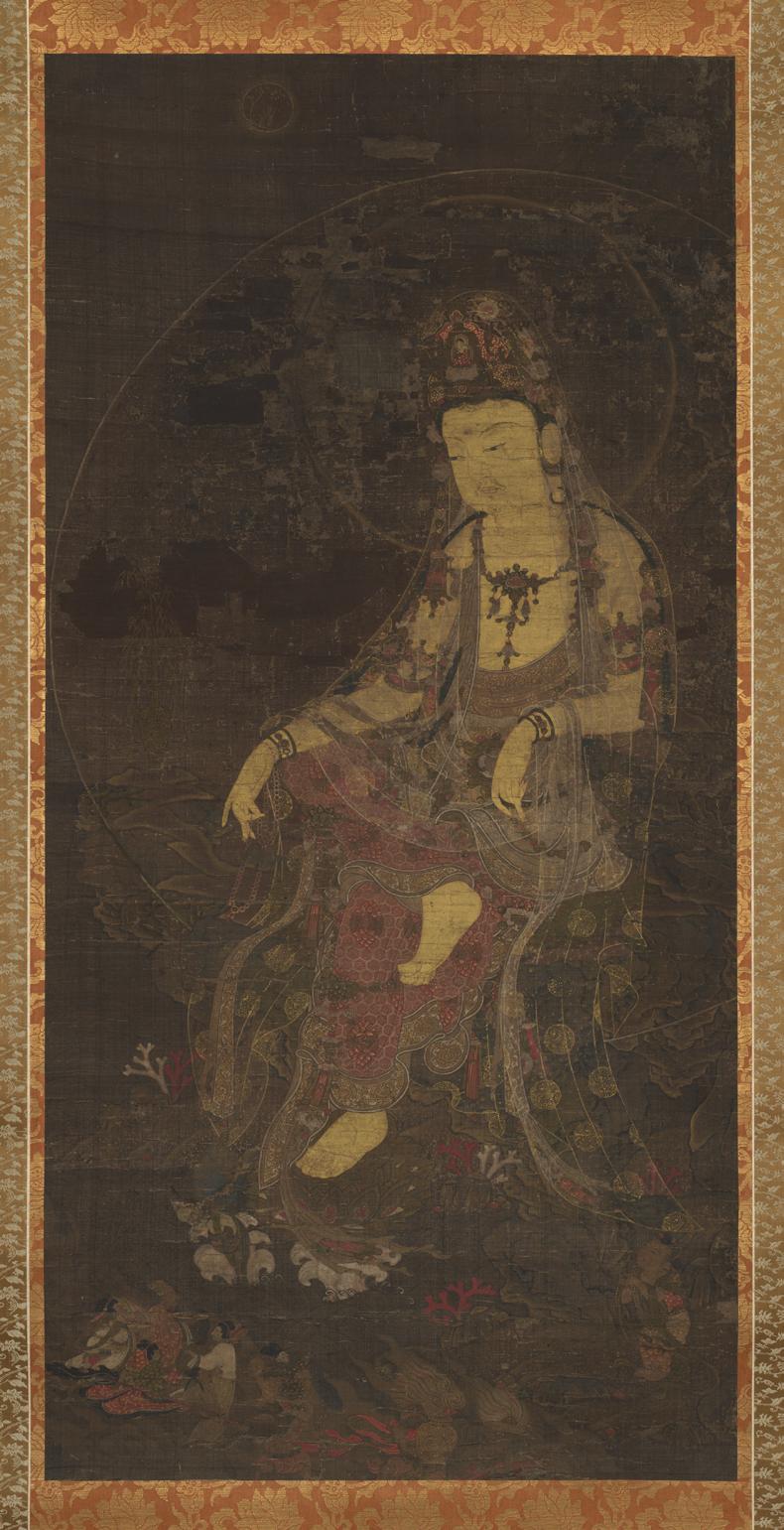
Fig. 7. Water-moon Avalokiteshvara, The Metropolitan Museum of Art, New York, Object No. 14.76.6. Open Access — The Met (www.metmuseum.org).
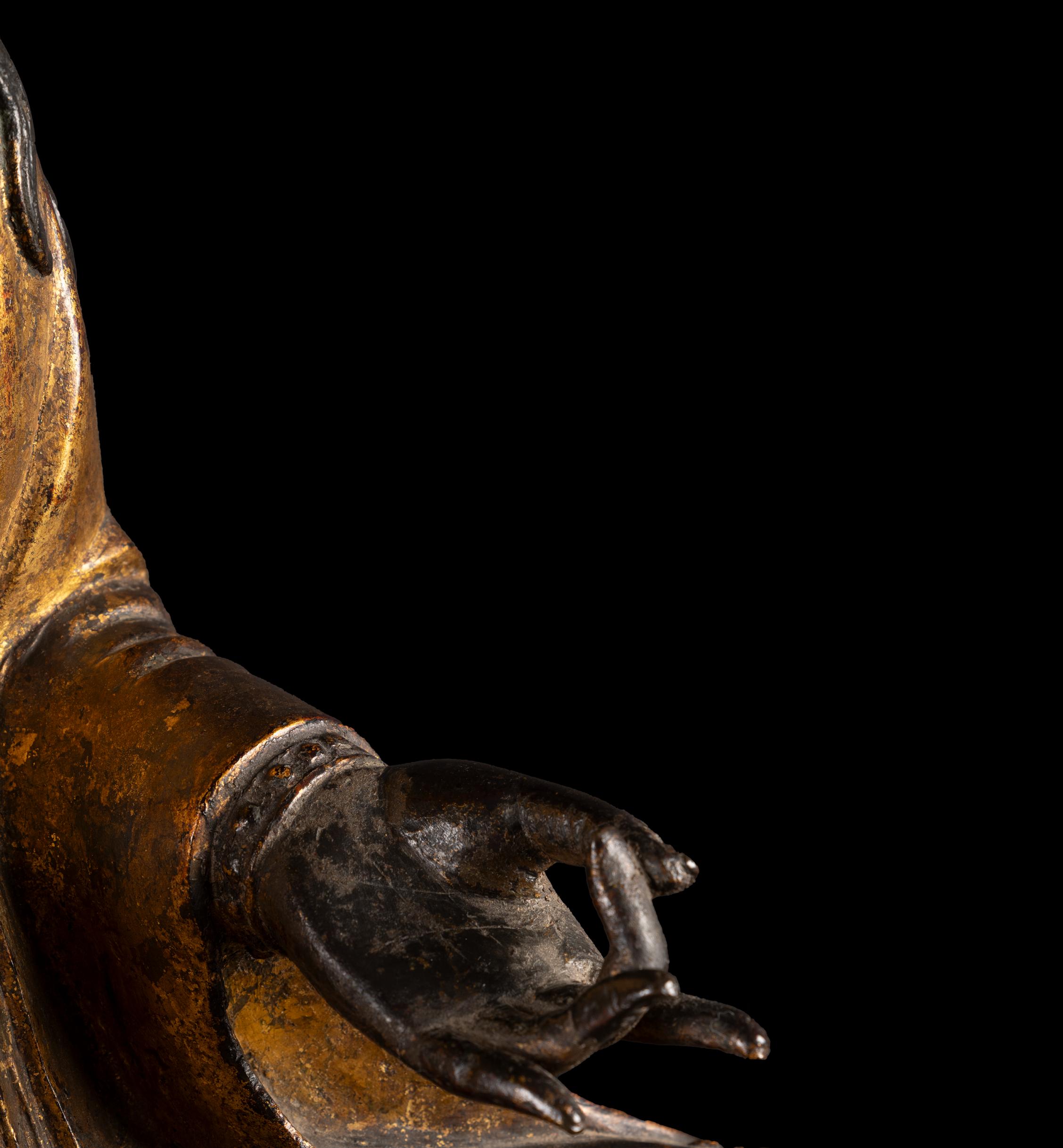
21. Illustrated in K. P. Kim, Choi, Ide, J. Y. Kim, Lee, Pak and Shulz 2003, pag. 160-161, pl. 47.
22. K. P. Kim, Choi, Ide, J. Y. Kim, Lee, Pak and Shulz 2003, pag. 142; Junghee Lee observes also that the figure lacks the triangular fold on the left thigh, a feature that becomes characteristic of late-Goryeo bodhisattva imagery. This absence, coupled with other shared traits, underscores the piece’s proximity to the developing late-period idiom without fully aligning it with the mature late-Goryeo canon.
23. K. P. Kim, Choi, Ide, J. Y. Kim, Lee, Pak and Shulz 2003, pag. 143.
24. The fifth, the sixth, seventh and eighth elements are also appreciable in the present sculpture, while the ninth, as noted above, is present on both thighs, once again confirming the exceptional delineation of this stylistic transition.
25. Cat. 덕수 4238, https://jeonju.museum.go.kr/relic.es?mid=a10504000000&seq=196&act=view; illustrated in Pak and Whitfield 2002, pl. 83, pag. 364.
26. Pak and Whitfield 2002, pl. 84, pag. 365.
27. Cat. 구6241, https://www.museum.go.kr/MUSEUM/contents/M0502000000.do?schM=view&searchId=search&relicId=4469; cat. 덕수 75, https://www.museum.go.kr/site/main/relic/ search/view?relicId=32142.
28. Shin, Yi and Park 2019, pag. 110.
29. Cat. 14.76.6, https://www.metmuseum.org/art/collection/search/36029
30. Cat. F1904.13, https://asia.si.edu/explore-art-culture/collections/search/edanmdm:fsg_F1904.13/
31. K. P. Kim, Choi, Ide, J. Y. Kim, Lee, Pak and Shulz 2003, pag. 144. The Song influence also confirmed in Shin, Yi and Park 2019, pag. 110.
32. Fu 2025, pag. 38-41.
33. Fu 2025, pag. 38.
Bibliography
Chewon Kim and Won-Yong Kim 1966, The Arts of Korea – Ceramics-Sculpture-Gold Bronze and Lacquer, London.
Fu Emma Yujia 2025, Res: Anthropology and Aesthetics Volume 83 Number 1 Spring 2025 pp. 22-48 – Configuring a transoceanic Avalokiteśvara-The Sennyūji statue, University of Chicago Press for the Peabody Museum of Archaeology and Ethnology Harvard University, Chicago.
Jeong Eunwoo 2013, Journal of Korean Art & Archaeology Vol.7 pp. 40-59 – Mid-Goryeo Buddhist Sculpture and the Influence of Song-Dynasty China, National Museum of Korea, Seoul.
Kumja Paik Kim, Eung-Chon Choi, Seinosuke Ide, Jae Yeol Kim, Junghee Lee, Youngsook Pak and Edward Shultz 2003, Goryeo Dynasty, Korea’s Age of Enlightenment, 918-1392, San Francisco.
Shin Soyeon, Yi Yonghee & Park Seungwon 2019, Research Report on a Seated Wooden Avalokiteshvara (duk 953) (English trans. Sunwoo Hwang; edited by Keith Wilson), National Museum of Korea; Freer Gallery of Art and Arthur M. Sackler Gallery, Seoul; Washington D.C.
Youngsook Pak and Roderick Whitfield 2002, Handbook of Korean Art, Buddhist Sculpture, London.
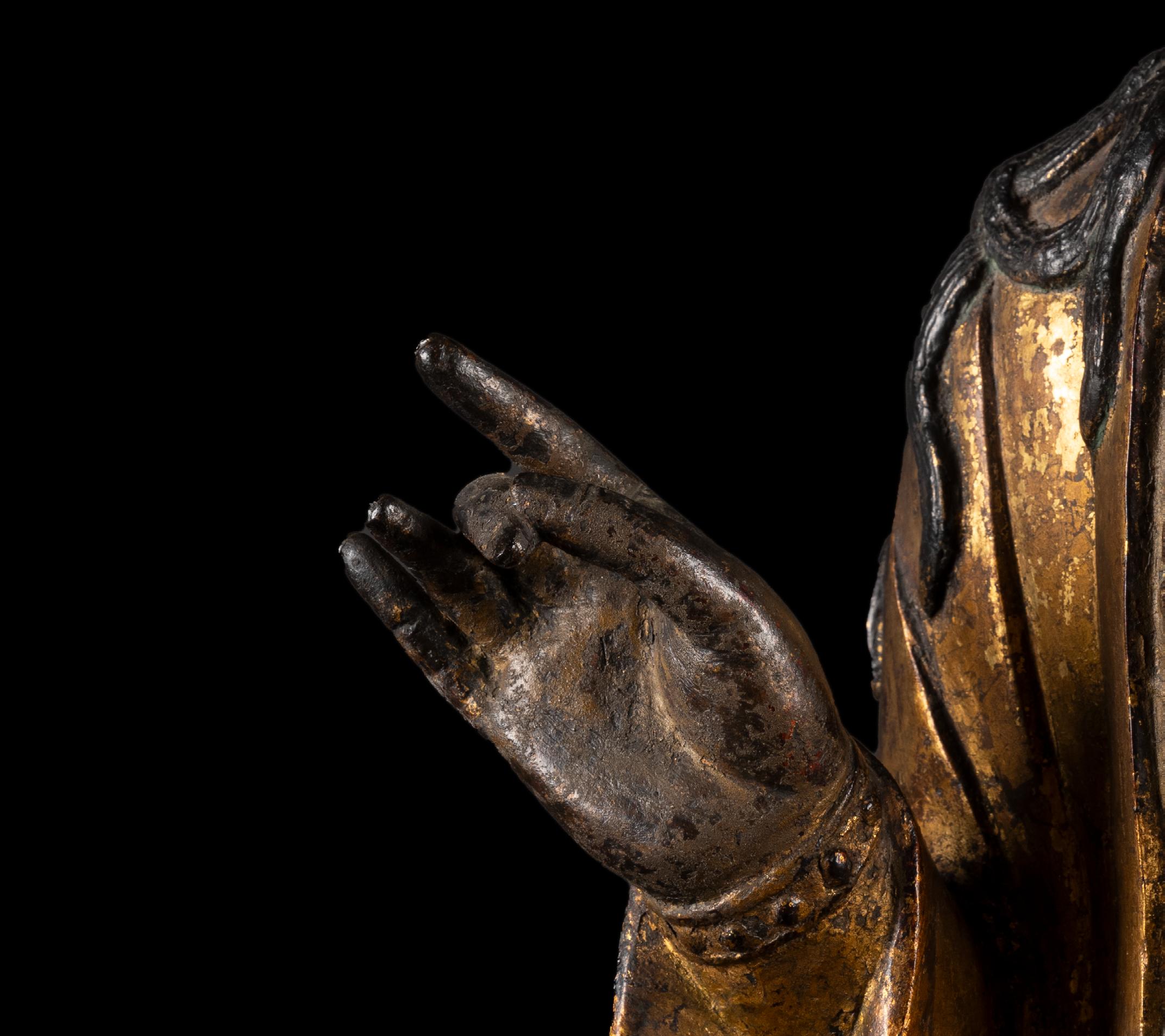

Scientific Data
This report synthesises the analytical evidence available for a gilt-bronze seated Gwaneum Bosal (h. 52 cm), and presents a reasoned attribution to the Goryeo dynasty (918–1392 CE).
The dataset comprises an independent thermoluminescence certificate by Oxford Authentication, a thermoluminescence analysis including a direct alpha-activity measurement on the casting core by Turin Thermoluminescence Analysis, and targeted handheld XRF spot analyses conducted by Dr Andrea Ciaroni (Olympus Vanta).
1. Thermoluminescence (TL): Oxford Authentication and TTA — data and interpretation
Oxford Authentication reports the last high-temperature event as “between 700 and 1000 years ago”, corresponding approximately to c. 1025–1325 CE and therefore placing the firing squarely within the Goryeo period.
Turin Thermoluminescence Analysis (TTA, Fantino) recorded De = 8.2 ± 0.7 Gy and a measured alpha activity used to refine the annual dose estimate; the laboratory reports a conservative interval 600–1000 CE with a central estimate ≈ c. 850 CE.
Although TTA’s central estimate is earlier than Oxford’s, both independent thermoluminescence (TL) assessments indicate an ancient high-temperature resetting of the casting-core material and are therefore inconsistent with recent manufacture. Oxford’s lower bound (≈1025 CE) lies only ~25 years after the conservative upper bound reported by TTA (≈1000 CE); this close adjacency of independently derived intervals is concordant with a last firing around the turn of the first and second millennia CE (late 10th–early 11th century) and, read conservatively, supports attribution to an early–mid Goryeo casting event
2.XRF compositional evidence and technological reading.
1. Alloy composition (bulk). The bulk rim/base Geochem(2) measurement (Dr A. Ciaroni) yields Cu 74.791%, Sn 12.533%, Pb 7.368%, Fe 1.384%, As 1.259%, Ag 0.618%. This composition corresponds to a ternary Cu–Sn–Pb alloy commonly observed in medieval Korean statuary. For direct comparison, published reference points include: statue in Goseongsa Temple [2] (low Pb) – Cu 81.26 / Sn 16.42 / Pb 1.72; statue in Janggoksa Temple [1] (high Pb) — Cu 68.80 / Sn 10.40 / Pb 17.10; selected intra-object points from a statue in the National Museum of Korea [3] (face/crown/wrist) demonstrate pronounced intra-object variability (see table), with localized zones of elevated Pb and marked Au/Hg surface enrichment. The subject alloy therefore occupies an intermediate position between the low- Pb and high-Pb endmembers documented in the Goryeo corpus, consistent with known workshop variability.
* Values of Gwaneum Bosal are from handheld/spot XRF; surface-weighted effects (gilding, lacquer, patina) and matrix effects can bias surface measurements.
2. The intermediate Pb content (≈7%) is within the technological envelope documented for Goryeo bronzes and is plausibly explained by differences in casting practice, object function and local workshop choices (e.g. selective use of high-lead alloys for small detailed elements versus lower-lead bulk alloys).
3. The measured Fe 1.384% and As 1.259%, together with residual Ag ≈ 0.4–0.7% across multiple runs, match signatures reported for other medieval Korean bronzes. Iron at ~1% commonly reflects ore or furnace/tool contamination; arsenic, although relatively high, is plausibly derived from sulfidic copper ores (e.g. chalcopyrite/arsenopyrite); residual silver is typical of argentiferous copper sources and incomplete historic desilvering. These impurity patterns favour traditional smelting/working rather than modern refined metal.
4. A targeted precious-metals run on the robe records Au 10.676% (Precious Metals profile) with no detectable Ni/Cr interlayers within the instrument LOD — a result that argues against modern electroplating. This composition is compatible with historic gilding practices; note that the absence of detectable Hg does not exclude historical amalgam because mercury may volatilise during firing and may fall below XRF detection limits.
5. The XRF signature measured on the black lacquered hair (strong organic fraction, LE ≈ 63%; Si, Ca, K; Cu/Sn/Pb attenuated beneath the film; Fe, Al, As at ppm levels) is qualitatively consistent with a traditional Goryeo lacquer system. Further comparisons with technical studies of Goryeo Buddhist bronzes show the same pattern: the National Museum of Korea reports a late-Goryeo/early-Joseon gilt-bronze seated bodhisattva [4] whose black surface (hair included) bears a lacquer layer mixed with bone powder, and experimental/analytical work confirms that bone powder (Ca, P) was commonly added to lacquers and produces a thicker, more rapidly curing lacquer layer— findings consistent with XRF by Dr Ciaroni (Ca, P, Pb attenuated beneath an organic film) [5]. The overall pattern — ternary Cu–Sn–Pb alloys with wide Sn/Pb variation, metallurgical impurities (Fe, As, Ag), surface Au enrichment and differences between surface and bulk due to lacquer/patina — is exactly the pattern documented in the regional literature. The XRF dataset therefore aligns with established metallurgical and finishing repertoires for high-quality Goryeo gilt bronzes.
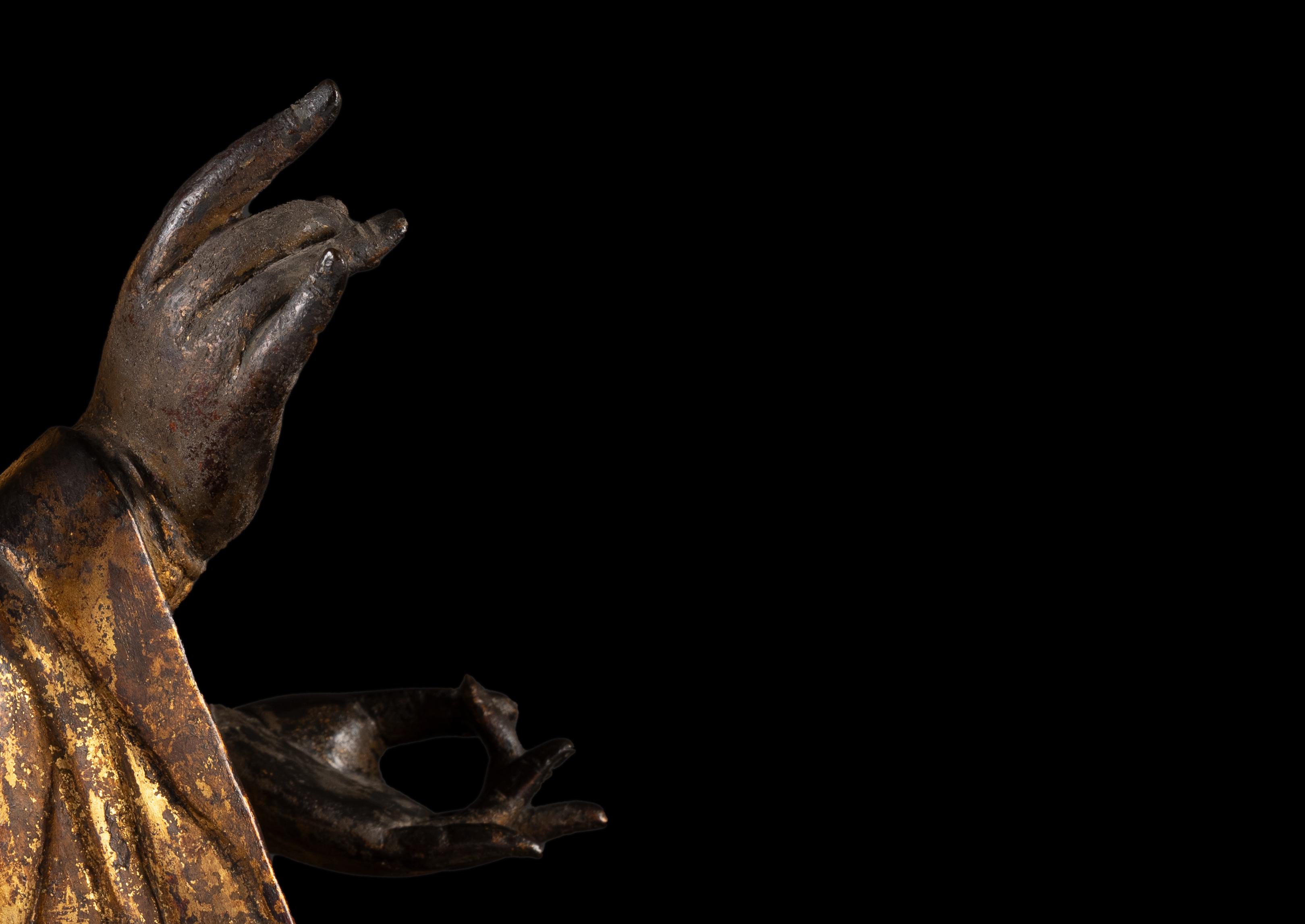
3. Conclusion
Independent, convergent lines of technical evidence support attributing the gilt-bronze Gwaneum Bosal to the Goryeo dynasty (918–1392 CE):
- Thermoluminescence: two independent TL assessments (Oxford Authentication certificate; TTA) both demonstrate an ancient clay casting core and therefore exclude recent manufacture.
- XRF and comparative metallurgical literature: the bulk Cu–Sn–Pb composition, trace impurities (Fe, As, Ag), the presence of genuine surface gilding (Au 10.676%), and the absence of modern plating markers (Ni/ Cr) are coherent with documented Goryeo workshop practice and finishing techniques.
Overall, the analytical package justifies a working attribution to the Goryeo dynasty.
Bibliography
[1] Bae Go Woon, Lee Sang Ok, Beom, Dae Geom, Chung, Kwang Yong 2018, Manufacturing Techniques and Provenance of Gilt bronze Seated Bhaisajyaguru (Medicine Buddha) Statue of Cheongyang Janggoksa Temple, Korea, Journal of Conservation Science, vol. 34, n.1, pag. 59–67.
[2] Bae Go Woon, Lee Sang Ok, Beom, Dae Geom, Chung, Kwang Yong 2024. Manufacturing Techniques of Bronze Seated Bodhisattva Statue of Goseongsa Temple in Gangjin, Korean Journal of Heritage: History & Science, vol. 57, n. 1, pag. 146–159.
[3] Gwak Hong In, Kwon Mi Hye 2019, A Study on Conservation and Manufacturing Techniques of a Seated Avalokiteshvara with a Thousand Hands of Goryeo Dynasty, Journalof Conservation Science, vol. 35, n. 3, pag. 253–258.
[4] Shin Soyeon 2017, Zoom in – Gilt-bronze seated Bodhisattva, National Museum of Korea, NMK Magazine, vol. 38.
[5] Park Jongseo 2024, Study on the Function of Bone Powder in the Drying of Asian Lacquer Containing it, Korean Journal of Conservation Science, vol. 40, n. 3.
